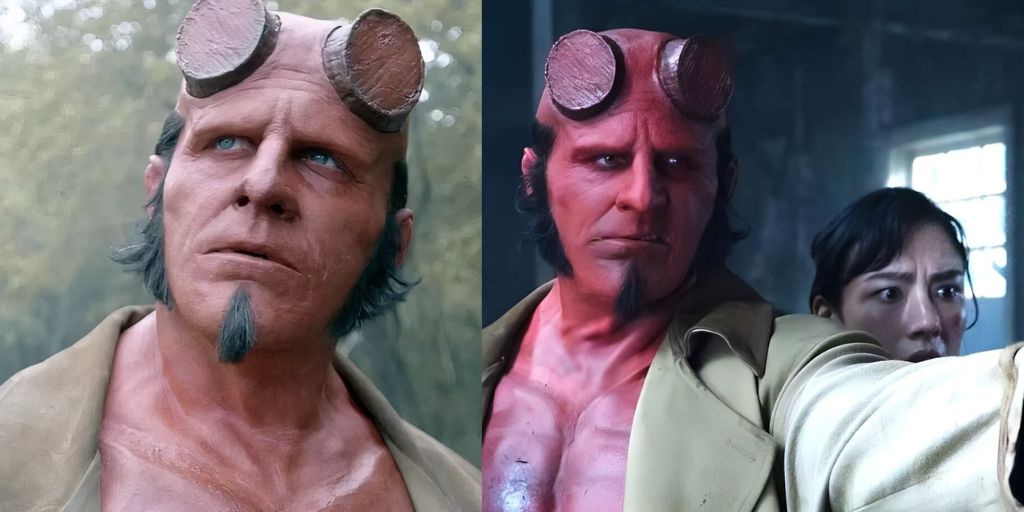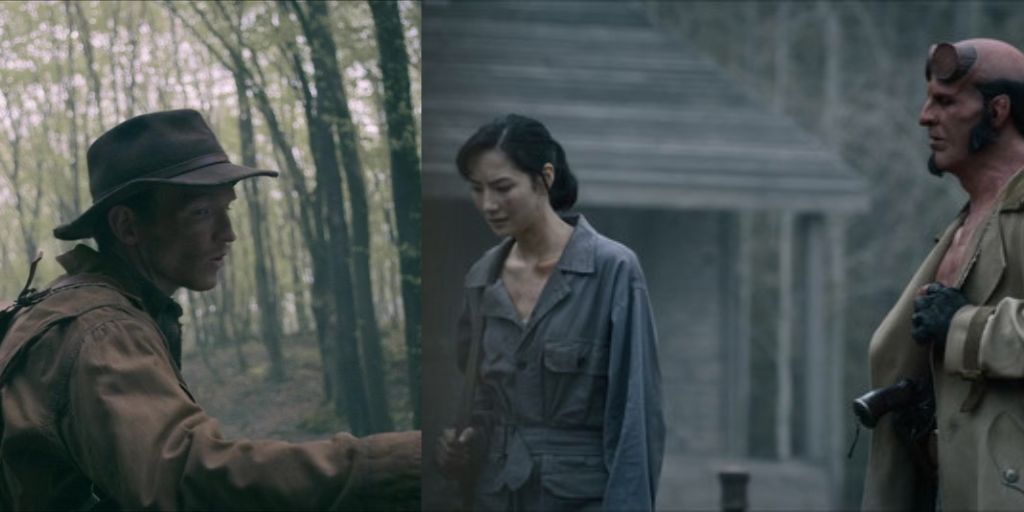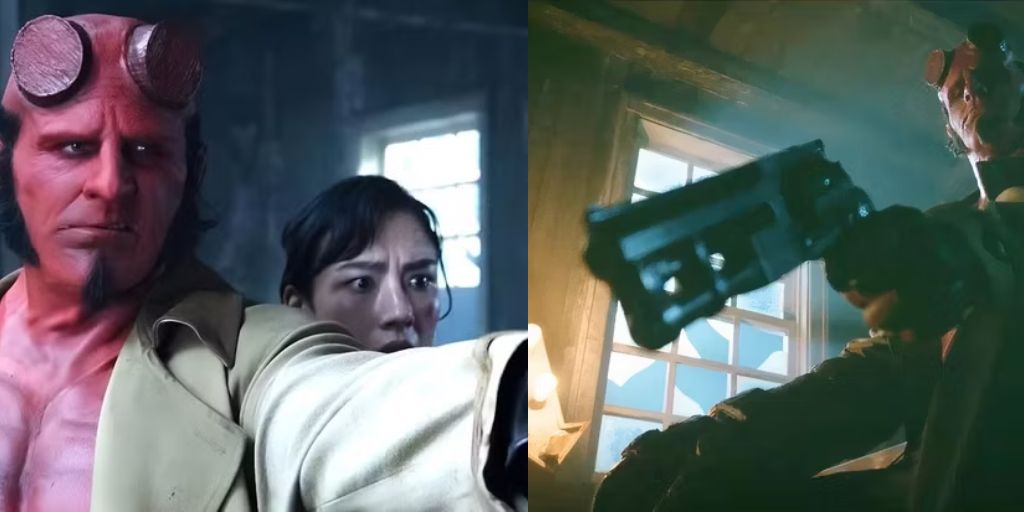Hellboy: The Crooked Man is the latest movie that attempts to bring Mike Mignola’s famous paranormal investigator back to life on the big screen. Many fans of Hellboy argue that this film could be the most loyal adaptation of the original comic book character.
Directed by Brian Taylor, the movie is based on a short comic series co-created by Mignola and the late artist Richard Corben. Mignola himself co-wrote the screenplay for the film, ensuring that the events follow the comic closely.
The story is set in 1958 and centers around Hellboy, a demonic creature raised by humans, who investigates paranormal occurrences for the Bureau for Paranormal Research and Defense (BPRD). Hellboy (portrayed by Jack Kesy) finds himself in the Appalachian mountains alongside Bobbie Jo Song (Adeline Rudolph), a rookie paranormal investigator.
During their journey, they meet Tom Ferrell (Jefferson White), a war veteran who has returned to his hometown to confront the dark past that haunts him.
The supernatural conflict they face involves a villain known as the Crooked Man (Martin Bassendale), with whom Tom once made a terrible deal. The movie follows the trio as they struggle to defeat the Crooked Man and survive in a world filled with magic, curses, and demons.
The movie’s key question is whether Hellboy will triumph or fall victim to the dark forces he faces. But unlike earlier Hellboy films where the titular character often emerges as the sole hero, this story shows that defeating evil requires teamwork.
Hellboy’s Journey: A Cinematic History
Before going deeper into The Crooked Man, it’s important to understand Hellboy’s cinematic history. Hellboy, a character created by Mike Mignola in 1993, first appeared in the comic book series Hellboy: Seed of Destruction.
He became an iconic figure in the comics world for his unique personality and distinctive appearance: red-skinned, with a stone-like right hand, two horns he grinds down, and a love for cigars.
He is the son of a demon and a witch, destined to bring about the Apocalypse, but he was raised by humans and works for the BPRD to protect the world from supernatural threats.
Hellboy made his cinematic debut in 2004, directed by Guillermo del Toro, and starring Ron Perlman in the lead role. Del Toro’s take on Hellboy blended gothic horror with a whimsical sense of adventure, receiving praise from critics and fans alike.
The success of the first film led to a sequel, Hellboy II: The Golden Army (2008), which was also directed by del Toro. Both films became fan favorites for their engaging storylines, impressive visuals, and deep connection to Mignola’s original comics.
After the del Toro films, there was a long period without a Hellboy movie until 2019, when director Neil Marshall’s reboot hit theaters.
This version, starring David Harbour, promised to be more faithful to the comics but was ultimately criticized for lacking the magic of del Toro’s films. Fans and critics alike felt the 2019 film focused too much on gory action and missed the heart and charm that made the original films stand out.
With Hellboy: The Crooked Man, the filmmakers aimed to deliver a movie that balances loyalty to the comics with a fresh perspective. Mignola’s close involvement with the project, including co-writing the screenplay, gave fans hope for a more faithful adaptation than previous attempts.
Setting the Stage: 1958 Appalachia and the Dark Magic of The Crooked Man
The Crooked Man opens in the Appalachian mountains in 1958, a time when superstition and folklore still held strong influence in rural areas. Hellboy and Bobbie Jo Song, a new member of the BPRD, find themselves in the remote mountain region, investigating strange supernatural happenings.
There, they encounter Tom Ferrell, a war veteran with a mysterious past and a deep connection to the dark magic that plagues the region.
The Appalachian mountains, with their deep forests, rugged landscapes, and isolated communities, provide the perfect backdrop for a story about curses, witches, and demons. The setting not only adds to the atmosphere of dread and mystery but also taps into the region’s rich folklore traditions.
Legends of witches, spirits, and pacts with the devil have long been part of Appalachian culture, making the setting feel both authentic and menacing.
Tom Ferrell, played by Jefferson White, is a key figure in the story. He grew up in these mountains and made a deal with the Crooked Man when he was young. The Crooked Man is a malevolent demon who promises wealth and power in exchange for Tom’s soul.
While Tom regretted his decision, the pact was sealed, and it has haunted him ever since. After serving in World War II, Tom returns to his childhood home to confront the darkness that continues to follow him.
The Crooked Man, portrayed by Martin Bassendale, is one of Hellboy’s most terrifying enemies. His power comes from the deals he makes with people, stealing their souls and using them to increase his own strength.

In the movie, the Crooked Man is depicted as a grotesque and deformed figure who lives in a decaying mansion deep in the mountains. His presence casts a shadow over the entire film, as Hellboy, Tom, and Bobbie Jo must figure out how to break the curse he has placed on Tom and stop him from causing more harm.
Bobbie Jo Song’s Magical Awakening
One of the key characters in Hellboy: The Crooked Man is Bobbie Jo Song, played by Adeline Rudolph. Bobbie Jo is a rookie investigator at the BPRD who, throughout the movie, discovers her own magical abilities. She starts the film unsure of her powers, but as the story progresses, she grows more confident and learns to harness her innate magic.
Bobbie Jo’s journey mirrors many classic hero’s journeys, where the protagonist discovers hidden strengths within themselves in the face of great adversity. Early in the movie, Bobbie Jo is eager to prove herself, but she lacks the control and confidence to tap into her magical abilities.
This changes when she faces a giant spider in the town’s catacombs alongside Watts, a local preacher played by Joseph Marcell.
Hellboy and Bobbie Jo initially came to the Appalachian mountains to investigate reports of a massive spider, and the confrontation with this creature becomes a turning point for Bobbie Jo. In the battle against the spider, she is able to cast a powerful spell that drives out the dark magic controlling it.
This victory not only gives Bobbie Jo the confidence she needs but also weakens the Crooked Man’s hold over the region. Bobbie Jo’s character development is one of the highlights of the movie, as she evolves from a novice into a powerful and essential member of the team.
Tom Ferrell’s Redemption and the Defeat of the Crooked Man
The heart of The Crooked Man is Tom Ferrell’s quest for redemption. Having made a deal with the Crooked Man years earlier, Tom has been carrying the weight of his mistake ever since. His story reflects classic themes of guilt, atonement, and the consequences of past actions.
The Crooked Man’s curse has haunted Tom, and he has been unable to escape it, no matter how hard he tried. One of the key elements of the curse involves a mystical object called a “witchball,” created by the witches of Tom’s village. This witchball is central to Tom’s plan to defeat the Crooked Man and lift the curse on his soul.
Hellboy, Tom, and Bobbie Jo join forces to confront the Crooked Man at his mansion. The battle is intense, with Hellboy facing visions of his own dark destiny. At one point, Hellboy’s mother appears in a vision, urging him to take his own life, and reminding him of his role in bringing about the Apocalypse.
Despite these disturbing visions, Hellboy pushes through and joins Tom in the final battle against the Crooked Man.
In a climactic moment, Tom forces the Crooked Man to consume the witchball, which weakens the demon significantly. Hellboy then delivers the final blow by using his Right Hand of Doom to pummel the Crooked Man before shooting him with his signature revolver, the Good Samaritan.
As the Crooked Man’s head is blown apart, gold coins pour from his skull, symbolizing the souls he has stolen over the years. This moment is both horrifying and poetic, as the Crooked Man’s evil is visually undone.
In the end, Hellboy gives one of the coins to Tom, symbolizing the lifting of the curse on Tom’s soul. Tom is finally free from the Crooked Man’s grip, and the film concludes with him and Bobbie Jo being airlifted to safety by the BPRD.
Effie Kolb’s Dark Fate: A Twist from the Comics
While the Crooked Man is the primary villain of the movie, another character plays a significant role in the story’s supernatural conflict: Effie Kolb. Played by Leah McNamara, Effie is a witch who plays a key role in Tom’s curse.
She originally encouraged Tom to make a deal with the Crooked Man, convincing him that it would make him a powerful witch. Effie’s manipulation of Tom led him down the path of darkness, and she continues to have power over him throughout the movie.
In a fitting end for the character, Effie meets a dark and poetic fate in the final moments of the film. After the Crooked Man is defeated, Hellboy and Tom encounter Effie in the woods, rapidly aging.
Earlier in the film, Tom mentioned that despite many years passing, Effie had remained the same age as him. This suggests that Effie had made her own deal with the Crooked Man for eternal youth.
In a scene lifted directly from the comics, Tom approaches Effie with the cursed bridle that she had once placed on his father, transforming him into a horse.
The film ends with the image of a white horse standing in the woods, with the words “Beware! I Am A Witch!” painted on its side, hinting at Effie’s final transformation. This moment is both eerie and symbolic, leaving a lasting impression on the audience.
A Standalone Story in a Franchise-Driven World
One of the most refreshing aspects of Hellboy: The Crooked Man is its status as a standalone film. In an age where film franchises are constantly expanding and interconnected universes dominate the box office, The Crooked Man stands out as a self-contained story.
During a panel at San Diego Comic-Con, director Brian Taylor was asked about the possibility of more Hellboy films. Taylor responded by saying that while he was open to the idea, The Crooked Man was always intended to be a standalone story.
“I hate it when folks try to do a movie and sell you a whole franchise… if the first one’s good, I’m coming back,” Taylor said. This approach aligns with the original Hellboy comics, where most of Hellboy’s adventures are standalone stories that can be read independently.
For fans of Hellboy, this approach is a welcome change. While the world of Hellboy is vast and filled with interesting characters, sometimes a simple, self-contained story can be more satisfying than a film that tries to set up a franchise. The Crooked Man delivers a complete story that respects its source material while offering something fresh for both longtime fans and newcomers.
The Challenges of Adapting Hellboy: A Mixed Reception
Despite its strengths, Hellboy: The Crooked Man has received mixed reviews. On the one hand, Jack Kesy delivers a solid performance as Hellboy, capturing both the gruff exterior and the underlying humanity of the character. Kesy’s portrayal has been praised as a worthy successor to Ron Perlman, who famously portrayed Hellboy in the del Toro films.
However, the film suffers from a limited budget, and this is particularly evident in the visual effects. The creatures and supernatural elements, while imaginative, often look underwhelming due to the film’s reliance on CGI. Fans of del Toro’s Hellboy films, which were known for their stunning practical effects and creature designs, may find the visuals in The Crooked Man lacking.
Additionally, the fact that The Crooked Man was released straight to video on demand (VOD) has led some to question whether there is still a future for Hellboy on the big screen.
The movie’s modest release strategy, combined with its mixed reception, leaves the future of the Hellboy franchise uncertain. While The Crooked Man is a far better adaptation than the 2019 reboot, it may not be enough to reignite the franchise.
What’s Next for Hellboy? Could Animation Be the Answer?
Given the mixed reception of Hellboy: The Crooked Man and the challenges of bringing Mignola’s unique world to life on a limited budget, some fans have suggested that the next step for Hellboy might be animation. Mike Mignola’s art style, with its bold lines and gothic atmosphere, lends itself well to the animated format.

An animated Hellboy film could capture the visual essence of the comics in a way that live-action films have struggled to do.
Mignola has previously expressed interest in animation, and there have been animated Hellboy projects in the past, such as Hellboy: Sword of Storms and Hellboy: Blood and Iron, which were well-received by fans.
If Hellboy is ever adapted again, a return to animation might be the best way to stay true to the character’s roots while delivering a visually stunning and faithful adaptation of Mignola’s work.
Hellboy: The Crooked Man is a solid adaptation that stays true to the spirit of Mike Mignola’s comics. While it may not have the big-budget spectacle of del Toro’s Hellboy films, it offers a faithful and engaging supernatural story with strong performances and a refreshing focus on a standalone narrative.
The future of Hellboy on the screen remains uncertain, but one thing is clear: fans of the character will continue to seek out new adventures, whether in live-action or animated form.


















